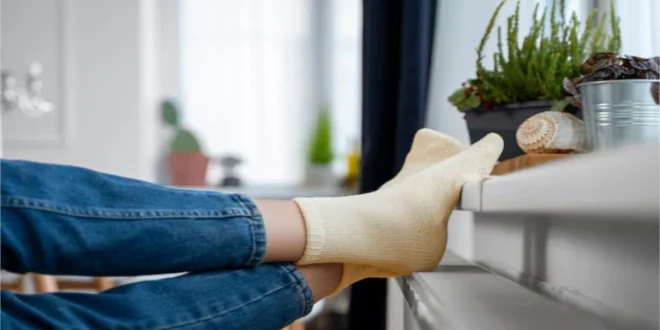Top 10 Work Socks for Unmatched Comfort and Durability
In our busy lives, socks might seem like a small, insignificant part of our daily wear. However, when it comes to work socks—especially if you’re someone on your feet for long hours—they can make or break your comfort, productivity, and overall experience on the job. Choosing the right work socks goes beyond aesthetics; it’s about selecting a reliable pair that meets specific needs, from durability and warmth to moisture-wicking and breathability.
This comprehensive guide explores everything you need to know about work socks, from materials and features to maintenance tips. Whether you’re in construction, healthcare, or an office setting, we’ll help you find the perfect pair.
1. The Importance of Quality Work Socks
While we often focus on our footwear, quality socks are equally important in supporting our comfort and health. Here’s why investing in high-quality work socks matters:
- Comfort: Long workdays can be grueling, especially for those constantly on their feet. Good work socks provide the cushion and support necessary to reduce fatigue and prevent discomfort.
- Protection: High-quality work socks help prevent blisters, abrasions, and chafing that might otherwise result from prolonged movement and moisture buildup.
- Thermal Regulation: Socks suited to your work environment help maintain the ideal temperature for your feet, ensuring warmth in colder conditions and ventilation in warmer ones.
- Moisture Management: Sweaty feet can lead to bacterial growth and odors. Moisture-wicking work socks are designed to keep feet dry and comfortable.
2. Types of Work Socks by Material
When it comes to work socks, material choice is one of the most important factors to consider. Different materials offer unique advantages and suit specific work environments:
a. Cotton Socks
Cotton is soft, breathable, and affordable. However, cotton alone is not ideal for long, high-intensity workdays due to its tendency to retain moisture.
- Pros: Soft and comfortable; affordable
- Cons: Poor moisture-wicking; takes a long time to dry
- Best for: Light, casual work environments
b. Merino Wool Socks
Merino wool is a premium option, highly valued for its natural moisture-wicking and insulating properties. It keeps your feet warm in the winter and cool in the summer.
- Pros: Excellent insulation; natural moisture-wicking; odor-resistant
- Cons: More expensive; can wear out faster in high-friction areas
- Best for: Cold environments, outdoor work, and long shifts
c. Synthetic Fiber Socks (Polyester, Nylon, and Spandex Blends)
Synthetic fibers are commonly blended with natural fibers to improve durability, stretch, and moisture management.
- Pros: Quick-drying; durable; affordable; retains shape
- Cons: Can trap odors; less breathable than natural fibers
- Best for: High-intensity work environments, athletic and outdoor settings
d. Bamboo Fiber Socks
Bamboo is a growing favorite in the sock industry due to its natural moisture-wicking properties, breathability, and eco-friendliness.
- Pros: Naturally antibacterial; breathable; sustainable
- Cons: Not as durable as synthetic materials
- Best for: Indoor work environments, individuals with sensitive skin
3. Key Features to Look for in Work Socks
When selecting work socks, keep an eye out for these critical features to maximize comfort and durability:
a. Cushioning
The right amount of cushioning can make all the difference, especially for those working on hard surfaces like concrete. Work socks come in various levels of cushioning:
- Light Cushioning: Ideal for office or light-duty work.
- Medium Cushioning: Suitable for moderate walking and standing jobs.
- Heavy Cushioning: Necessary for high-impact jobs requiring prolonged standing or walking.
b. Moisture-Wicking Technology
A good pair of work socks should manage sweat efficiently to keep your feet dry. Look for materials like merino wool or synthetic blends with moisture-wicking properties.
c. Arch Support
Work socks with built-in arch support reduce foot fatigue and provide stability, especially for individuals with flat feet or those working long hours.
d. Reinforced Heels and Toes
These areas endure the most wear and tear, so reinforced heels and toes can extend the life of your socks. Look for socks with extra padding in these zones.
e. Compression
Compression socks are designed to promote better blood flow and reduce swelling in the legs and feet. This feature is particularly beneficial for people in healthcare, construction, or any field that requires long hours of standing.
4. Choosing the Right Work Socks for Different Jobs
Different professions require specific types of socks for comfort and support. Here’s a quick guide to help you choose:
a. Construction and Outdoor Jobs
For construction and other outdoor jobs, you need durable, well-insulated, and moisture-wicking socks. Merino wool or thick synthetic fiber socks with heavy cushioning are ideal.
b. Healthcare and Hospitality
Healthcare and hospitality workers often spend long hours on their feet. Lightweight, breathable, and moisture-wicking socks with compression support can make shifts more bearable.
c. Office Work
Office settings may not require the same level of durability as outdoor jobs, but comfort remains essential. Lightweight cotton-blend socks or bamboo fiber socks work well for a typical office environment.
5. Proper Sock Maintenance: Extending the Life of Your Work Socks
Maintaining your work socks correctly not only extends their life but also ensures they retain their comfort and support features:
- Wash with Care: Avoid using hot water or harsh detergents. Cold water and a gentle cycle can help preserve the fabric.
- Avoid Fabric Softeners: Softeners can clog the fibers and reduce moisture-wicking capabilities.
- Air-Dry: Avoid using a dryer, as it can break down elastic and shrink the material.
- Rotate Socks: Having several pairs of good-quality socks and rotating them can prevent excessive wear and extend their life.
6. Top Brands for Work Socks
With so many options on the market, here are some popular brands that stand out for their durability, comfort, and design:
a. Darn Tough
Known for their lifetime warranty, Darn Tough offers high-quality merino wool socks with durability that’s hard to beat.
b. Carhartt
Carhartt produces rugged socks ideal for outdoor and construction jobs, with reinforced heels and toes and moisture-wicking properties.
c. Dickies
Dickies work socks are affordable and durable, designed for high-intensity, long-hour wear.
d. Smartwool
Smartwool offers merino wool socks tailored for comfort, breathability, and moisture control, making them ideal for various work environments.
e. Wigwam
Wigwam socks combine synthetic fibers with natural wool to offer a durable, moisture-wicking solution for long work hours.
7. The Role of Compression Socks in the Workplace
Compression socks, often overlooked, are a game-changer for people in physically demanding jobs. These socks provide graduated compression, which means they’re tighter around the ankle and loosen as they go up the leg, promoting better blood circulation.
Benefits of Compression Socks for Work
- Reduced Swelling: Compression socks help reduce leg and foot swelling, making them ideal for people who stand for long hours.
- Enhanced Comfort: By reducing muscle fatigue, compression socks provide added comfort during long shifts.
- Injury Prevention: Compression socks can aid in muscle stabilization, lowering the risk of sprains or muscle injuries.
8. How to Determine Your Sock Size
Finding the right size is crucial for maximum comfort. Most socks come in size ranges rather than individual sizes, but it’s still important to measure your foot:
- Check Size Charts: Brands often have their sizing charts. Measure your foot length and compare it with the chart to find the best fit.
- Consider Sock Thickness: Thicker socks may require a half-size larger shoe, especially if you’re wearing work boots.
9. Work Sock Care Tips for Extended Durability
Maintaining your work socks can significantly extend their life, even with daily wear. Here are some tips for care and maintenance:
- Wash Socks Inside Out: Washing socks inside out reduces pilling and ensures the fabric stays smooth.
- Separate by Color: Dark-colored socks should be washed separately to avoid dye transfer.
- Dry Naturally: Avoid tumble drying; air-drying will help the fibers retain their integrity.
10. Innovations in Work Sock Technology
The work sock industry has evolved, with brands introducing new technologies for comfort and functionality:
a. Anti-Odor Technology
Some brands now incorporate antimicrobial properties into the sock fibers to reduce odors, ideal for those working long hours.
b. Smart Fabric Blends
Blends of materials like bamboo, merino wool, and synthetic fibers optimize breathability, durability, and moisture-wicking.
c. Built-in Temperature Regulation
Certain socks have temperature-regulating fibers that adjust according to body heat, ideal for workers in varying climates.
Conclusion: Investing in Your Comfort and Health
Choosing the right work socks is an investment in your comfort, productivity, and overall well-being. By understanding the materials, features, and types of socks available, you can make an informed choice that aligns with your work environment and personal preferences. Whether you’re in healthcare, construction, or an office, the perfect pair of socks is out there waiting to support you through every step of your workday.
Frequently Asked Questions (FAQs)
What are the best materials for work socks?
The best materials for work socks depend on your work environment and needs. Merino wool is excellent for moisture-wicking and insulation, making it ideal for cold or outdoor conditions. Synthetic blends (such as polyester and nylon) are known for durability and quick-drying properties, making them perfect for active and high-intensity work. Bamboo fibers are another option for breathable, eco-friendly, and antibacterial socks, ideal for indoor environments or those with sensitive skin.
How do I prevent my work socks from slipping down during the day?
To prevent work socks from slipping, look for socks with ribbed cuffs or elastic bands that provide a secure fit around the calf or ankle. Compression socks are also a great choice, as they are designed to stay in place. Additionally, ensure you’re wearing the correct size since oversized socks are more likely to slide down as you move.
Are compression socks beneficial for long work shifts?
Yes, compression socks can be very beneficial for people working long shifts, especially in physically demanding jobs. Compression socks improve blood circulation, reduce swelling, and relieve fatigue by providing gentle pressure on the legs. This can be particularly helpful for healthcare workers, construction workers, or anyone standing for extended periods.
How often should I replace my work socks?
The lifespan of work socks varies based on material quality and frequency of use. Generally, high-quality work socks should last between 6 to 12 months with regular wear. Signs that it’s time for a replacement include thinning fabric, loss of elasticity, and visible wear in the heels or toes. Rotating between multiple pairs and proper washing can help extend their life.
What’s the best way to wash work socks to maintain durability?
To extend the life of your work socks, wash them inside out on a gentle cycle in cold water and avoid using fabric softeners. Air-drying instead of machine drying is also recommended to prevent shrinking and preserve elasticity. For wool socks, use a mild detergent and avoid hot water, as it can cause them to lose their shape.
How do I choose the right thickness for work socks?
The right thickness for work socks depends on your footwear, job environment, and comfort needs. Thicker socks provide extra cushioning and warmth, which is ideal for heavy-duty boots or cold climates. Thinner socks, on the other hand, offer breathability and are better suited for warmer conditions or jobs requiring more lightweight footwear. Consider a medium thickness if you work indoors and need a balance of comfort and breathability.
READ ALSO: Introduction: The Timeless Appeal of “Forever” Products
 Touch Blog
Touch Blog



